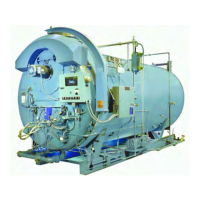Chapter 3 — Waterside Care and Requirements
3-8 Part No. 750-184
Objectives of water treatment in general are:
1. Prevent hard scale deposits or soft sludge deposits, which reduce
heat transfer and can lead to overheated metal and costly
downtime and repairs.
2. Eliminate corrosive gases in the supply or boiler water.
3. Prevent intercrystalline cracking or caustic embrittlement of
boiler metal.
4. Prevent carryover and foaming.
Accomplishment of the above objectives generally requires proper
feedwater treatment before and after introduction of the water into
the boiler. The selection of pre-treatment processes depends upon
the water source, its chemical characteristics, amount of makeup
water needed, plant operating practices, etc. Treating methods
include filtering, softening, de-mineralizing, deaerating, and
preheating. After-treatment involves chemical treatment of the
boiler water.
Because of the variables involved, no single boiler compound can
be considered a “cure-all” nor is it advisable to experiment with
homemade treating methods. Sound recommendations and their
employment should be augmented by a periodic analysis of the
feedwater, boiler water, and condensate.
The internal or waterside surfaces of the pressure vessel should be
inspected with enough frequency to determine the presence of any
contamination, accumulations of foreign matter, or corrosion, and/
or pitting. If any of the conditions are detected, contact your local
Cleaver-Brooks authorized representative for advice on corrective
action.
A properly sized water meter should be installed in the raw water
make-up line in order to accurately determine the amount of raw
water admitted to the boiler (steam or hot water) and to aid in
maintaining proper waterside conditions.
D. CLEANING
1. HOT WATER AND STEAM PIPING
Steam and water piping systems connected to the boiler may
contain oil, grease, or foreign matter. The impurities must be
removed in order to prevent damage to pressure vessel heating
surfaces. On a steam system, the condensate should be wasted
until tests show the elimination of undesirable impurities. During
the period that condensate is wasted, attention must be given to the
treatment of the raw water used as make-up so that an
accumulation of unwanted materials or corrosion does not occur.
For more information, contact your local Cleaver-Brooks authorized
representative.
On a hot water system, chemical cleaning is generally necessary
and the entire system should be drained after treatment. Consult

